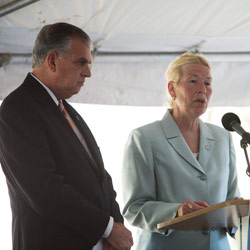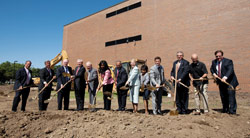Artful Technology in Pursuit of a Cure

The noted American sociologist Daniel Bell once suggested that, “Technology, like art, is a soaring exercise of the human imagination.” He went on to contrast technology with art, stating that, “Art is an end in itself; its values are intrinsic,” whereas, “Technology is the instrumental ordering of human experience within a logic of efficient means, and the direction of nature to use its powers for material gain.” The new Cancer Research Center project, which recently broke ground at the University of Illinois College of Medicine at Peoria campus here in the heart of downtown Peoria, brings together both high art and high technology, in the noble pursuit of a cure for cancer.
Technology Plays in Peoria
This new Cancer Research Center arrives on the scene in the midst of an unprecedented medical renaissance in the Greater Peoria Area. OSF Saint Francis Medical Center has just put the finishing touches on its substantial Milestone Project addition to its own downtown Peoria campus. Methodist Medical Center has recently opened its full-service, high-technology health facility on the burgeoning north side of town. And, in another broadly collaborative local medical effort, the cutting-edge Jump Trading Simulation and Conference Education Center at that same downtown OSF Saint Francis campus will soon be on the drawing boards.
 The Peoria contribution to the global issue of a cure for cancer received a significant boost nearly ten years ago, when noted researcher Dr. Jasti Rao first arrived in town to establish his program at the College of Medicine. Under his careful guidance and the strong leadership of Dr. Sara L. Rusch as regional dean, the program has grown and prospered. Yet, in order to take the next critical steps toward that cure for cancer—and attract additional researchers from other corners of the world—the University and its partners recognized the need for a technologically advanced laboratory. In 2007, the commitment was made to provide such a dedicated facility.
The Peoria contribution to the global issue of a cure for cancer received a significant boost nearly ten years ago, when noted researcher Dr. Jasti Rao first arrived in town to establish his program at the College of Medicine. Under his careful guidance and the strong leadership of Dr. Sara L. Rusch as regional dean, the program has grown and prospered. Yet, in order to take the next critical steps toward that cure for cancer—and attract additional researchers from other corners of the world—the University and its partners recognized the need for a technologically advanced laboratory. In 2007, the commitment was made to provide such a dedicated facility.
The Cancer Research Center
If, as the sociologist Bell suggests, technology is a “soaring exercise of the human imagination,” the new Cancer Research Center now getting under construction showcases exactly how high that imagination can go. Its 20,000 square feet of research laboratories and adjunct spaces (on two levels) incorporate the latest scientific concepts in layout and infrastructure support. In addition, these labs and adjunct spaces are being outfitted with all the necessary cutting-edge equipment to further the study of the molecular, cellular and genetic characteristics of cancer.
This unique and creative high-technology research venue is mirrored by the equally unique method in which this facility is being delivered to the College of Medicine campus here in Peoria. Recognizing both the economic and quality-of-life importance of this project to the region, the Heartland Foundation has brought together a strong collaboration of stakeholders to see it to fruition. Upon completion, it will join other campus buildings as an integral part of this ever-expanding academic medical complex.
And, so as not to forget the “art” part of Bell’s technology-art equation, the Cancer Research Center will provide a new central entryway, complete with a “soaring” sail feature, to act as an entry beacon and landmark for the entire campus.
A Sustainable Endeavor
No project can be considered an unqualified success in our new century without passing the critical “sustainability” litmus test. The new Cancer Research Center offers several possibilities for passing such a test. In terms of geography, the Heartland Foundation and its community stakeholders have chosen to locate this critical facility in the very heart of downtown Peoria (and its regional medical zone), thus tapping into the existing infrastructure and embedded energy that this location has to offer. In terms of its architecture, it attaches to the existing college medical facility, sharing numerous important building infrastructures and systems. And perhaps most profoundly, in terms of its mission, few endeavors could be more sustainable than an urban research facility that seeks a cure to a disease that afflicts an additional 10 million of the world’s people each and every year.
Conclusion
When completed next fall, the Cancer Research Center at the University of Illinois College of Medicine at Peoria’s campus will bring a new level of technological prowess to bear on the noble pursuit of a cure for cancer. To paraphrase sociologist Bell, it will allow the imaginations and the creativity of its researchers to soar, so that they might arrive at the necessary scientific breakthroughs that will ultimately lead to that cure. iBi

